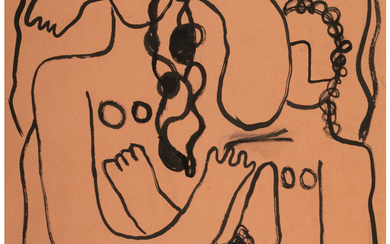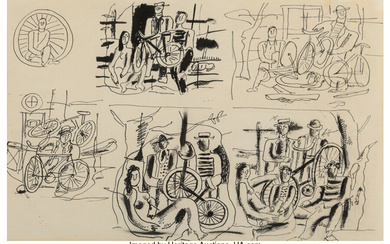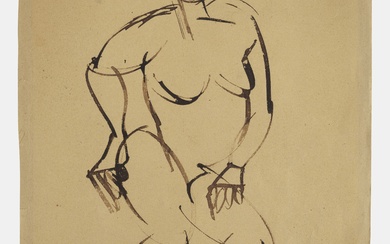Fernand Léger - Composition mécanique
Fernand Léger
Composition mécanique
1923
Graphite drawing on paper 36,9 x 27,2 cm Framed under glass. Monogrammed and dated 'F. L 23' lower right.
Throughout his life Fernand Léger nurtured a positive relationship to the modernism of the machine age. In 1917 a phase began in Léger's work that was based on his very individual interpretation of Cubism, and it continued until around 1923: during this time he primarily combined elements borrowed from the world of machines into geometrical abstract compositions. This period in Léger's oeuvre is generally referred to as his “Mechanical Period”.
Léger's works of this period involve more than just a machine aesthetic. His declared aim was something else: “Many people would be receptive to unintentional beauty (as an optical fact) if they were not blinded by the preconceived notion of the artwork. [...] The beautiful is everywhere: in their row of pans, on the white wall of their kitchen, and perhaps more so there than in their Louis XV salon or in the official museums. Therefore, I will now speak about a new architectonic genre: the architecture of the machine. [...] This much can be said: a machine or an industrial product can be beautiful if the proportions of the inner construction of such bodies achieve a balance at a level corresponding to that of earlier architectural styles.” (cited in: Galerie Beyeler (ed.), Fernand Léger 1881-1955, Basel 1969, p. 37).
Fernand Léger's way of working was always characterised by a thoughtful process diametrically opposed to the spontaneous gesture. Leaving nothing to chance, he used numerous drawings and gouaches to meticulously prepare his paintings (exhib. cat. Galerie Beyeler, op. cit., Basel 1969, p. 58). Our drawing can thus be seen as the direct model for the 1924 painting “Élément mécanique”, which is now in the Musée National d'Art Moderne, Centre Georges Pompidou in Paris.
Certificate
With a photo-certificate by Irus Hansma, Paris, dated 30 September 2015; Irus Hansma will include the work in her "Répertoire des oeuvres sur papier de Fernand Léger", currently under preparation (archive no. 111/09/2015).
Provenance
Private possession, USA; Trade New York (2009, private donation for charity purposes); Private possession since, USA
View it on
Estimate
Time, Location
Auction House
Fernand Léger
Composition mécanique
1923
Graphite drawing on paper 36,9 x 27,2 cm Framed under glass. Monogrammed and dated 'F. L 23' lower right.
Throughout his life Fernand Léger nurtured a positive relationship to the modernism of the machine age. In 1917 a phase began in Léger's work that was based on his very individual interpretation of Cubism, and it continued until around 1923: during this time he primarily combined elements borrowed from the world of machines into geometrical abstract compositions. This period in Léger's oeuvre is generally referred to as his “Mechanical Period”.
Léger's works of this period involve more than just a machine aesthetic. His declared aim was something else: “Many people would be receptive to unintentional beauty (as an optical fact) if they were not blinded by the preconceived notion of the artwork. [...] The beautiful is everywhere: in their row of pans, on the white wall of their kitchen, and perhaps more so there than in their Louis XV salon or in the official museums. Therefore, I will now speak about a new architectonic genre: the architecture of the machine. [...] This much can be said: a machine or an industrial product can be beautiful if the proportions of the inner construction of such bodies achieve a balance at a level corresponding to that of earlier architectural styles.” (cited in: Galerie Beyeler (ed.), Fernand Léger 1881-1955, Basel 1969, p. 37).
Fernand Léger's way of working was always characterised by a thoughtful process diametrically opposed to the spontaneous gesture. Leaving nothing to chance, he used numerous drawings and gouaches to meticulously prepare his paintings (exhib. cat. Galerie Beyeler, op. cit., Basel 1969, p. 58). Our drawing can thus be seen as the direct model for the 1924 painting “Élément mécanique”, which is now in the Musée National d'Art Moderne, Centre Georges Pompidou in Paris.
Certificate
With a photo-certificate by Irus Hansma, Paris, dated 30 September 2015; Irus Hansma will include the work in her "Répertoire des oeuvres sur papier de Fernand Léger", currently under preparation (archive no. 111/09/2015).
Provenance
Private possession, USA; Trade New York (2009, private donation for charity purposes); Private possession since, USA







